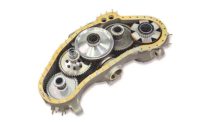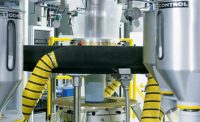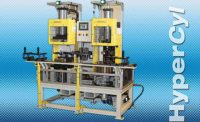Ryobi Die Casting (USA) Inc. in Shelbyville, IN, supplies precision transmission castings to the automotive industry. Recently, an improvement they developed for a high-volume automatic transmission side cover led directly to the need for a new assembly system to handle a 100 percent increase in production.
Ryobi had been assembling the side covers with a labor-intensive hybrid process including many manual operations, but that had to change to meet the customer’s expectations. That’s when Magna Machine and Tool in New Castle, IN, got involved. Magna is a full-service tool and die shop that also designs and builds automated equipment for machining and assembly.
“We worked closely with Ryobi to develop a solution that met their requirements,” says Rich Foster, Magna’s sales manager. “We had built much of the equipment they were using for the original assembly, so we understood the process. We couldn’t just duplicate that equipment, though, because they wanted significantly more automation and, above all, they wanted comprehensive data to satisfy the customer’s tracking and analysis requirements.
“Another of our large automotive customers had a significant number of assembly machines equipped with electromechanical servo presses supplied by Promess Inc. We had reworked several of those machines for that customer and in the process developed a good relationship with Promess,” Foster says. “We knew the Promess presses and control systems could handle the assembly operations and, equally important, supply the detailed data Ryobi’s customer required.”
The machine Magna built for Ryobi is a fully automated six-station assembly system that can be loaded manually or robotically.
The sequence of operations is as follows:
- Station 1: Loading.
- Station 2: Install a baffle plate and secure with two screws.
- Station 3: Install a steel sleeve in a bore.
- Station 4: Install a bearing above the sleeve that must not contact it.
- Station 5: Install an O-ring-equipped seal bolt to close an oil passage.
- Station 6: Install an aluminum plug in a hole.
The critical pressing operations at stations 3, 4 and 6 are all performed by a Promess Electro-Mechanical Assembly Press (EMAP). Of these operations, installing the aluminum plug at Station 6 is the most difficult.
“There is a good bit of interference fit between the plug and the hole,” says Foster. “We had to lubricate the plugs before insertion to prevent galling between the aluminum plug and the aluminum side plate. That operation required a lot of operator intervention and maintenance in the old system. It was one of the things we really wanted to eliminate in the new process, and the Promess EMAP made it possible.”
“Seating depth on the plug is really critical because the hole it seals is drilled into an oil passage in the side cover. If the plug is inserted too far, which was easy to do with an undersized plug or an oversized hole, then the passage is blocked and the transmission does not function properly,” he adds.
The EMAP is a CNC press consisting of a ballscrew driven by a servomotor. It’s equipped with an array of sensors to measure position, force and other process parameters. The EMAP applies force with great precision while measuring the functional result and feeding that data back into the control system.
In the plug insertion operation, for example, the force-distance “signature” of each press stroke is compared in real-time to the signature of a known good operation. As long as the operation’s signature falls within the acceptable tolerance zone, both the location of the plug and the retention provided by the interference fit are assured. The same is true of the pressing operations accomplished at stations 3 and 4.
Data from each pressing operation is collected and stored by Ryobi’s customer for tracing and analysis. “I can think of several occasions…when we used the force-distance data to diagnose a problem,” says Dave Scott, Ryobi’s senior manufacturing engineer. “We have also used the data to trace questionable parts from various suppliers [so they could] improve their processes as well.”
“This machine is the result of a very successful team effort,” adds Foster. “Ryobi, Magna and Promess all worked together to make it happen and deliver it on time. Promess and our electrical subcontractor, Cummins Electric, in particular, spent a lot of time and effort to make sure the critical communication issues between the EMAPs and the PLC were all resolved before the system went on line.”
“Our engineers spent a good bit of time in the Promess Process Development Center,” Foster says. “It’s a state-of-the-art facility…that allowed us to simulate customer applications and develop solutions that we applied to Ryobi’s real hardware with a high degree of confidence. The data we carried back to Ryobi from these sessions played a big part of convincing them that the solution would work as planned.”
“We’ve had a few start-up issues,” Scott says, “but actually a lot less than with most other new systems. Promess has been extremely helpful providing both training for our operators and technical assistance in debugging the very few issues we’ve encountered.
“The technology is really solid,” he adds. “Our operators quickly learned how to bring up data and graphics to help them diagnose issues and tweak the system. Being able to see a picture of the operation right there at the machine is really valuable.
“The machine is also very compact because it doesn’t need a lot of floor space for hydraulic power units and such,” Scott adds. “We actually installed it within the footprint of the old system, which let us bring it on stream without interrupting production. That’s a major benefit, because adding floor space was not part of the bargain we made with our customer.”
Editor’s note: Whether you’re a systems integrator or the in-house automation team of an OEM, if you’ve designed a system that you’re particularly proud of, tell us about it. Send an e-mail to John Sprovieri, editor of ASSEMBLY, at sprovierij@bnpmedia.com, or call 630-776-0924.




